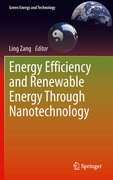
Reflecting the rapid growth of nanotechnology research and the potential impact of the growing energy crisis, Energy Efficiency and Renewable Energy Through Nanotechnology provides comprehensive coverage of cutting-edge research in the energy-related fields of nanoscience and nanotechnology, which aim to improve energy efficiency and the generation of renewable energy. Energy Efficiencyand Renewable Energy Through Nanotechnology tightly correlates nanotechnologywith energy issues in a general, comprehensive way that makes it not only suitable as a desk reference for research, but also as a knowledge resource for the non-expert general public. Readers will find Energy Efficiency and Renewable Energy Through Nanotechnology useful in a variety of ways, ranging from the creation of energy policy, to energy research development, and to education innanotechnology and its application to energy-related problems. It can also beused as a primary or supplementary textbook for energy-related courses for advanced undergraduate and graduate students. Provides cutting-edge research on energy-related nanotechnology. Offers a comprehensive look at energy-related nanotechnology as a whole, rather than covering highly-specialised topics. Written by international experts in energy-related nanotechnology INDICE: 1. Enhancement of Si Based Solar Cell Efficiency via NanostructureIntegration. 2. Organic and Hybrid Solar Cells Based on Small Molecules. 3. Organic Solar Cells with Inverted and Tandem Structures. 4. Organic Solar Cellsand Their Nanostructural Improvement. 5. On the Importance of Morphology Control for Printable Solar Cells. 6. Development of Low Band Gap Polymers for Roll-to-Roll Coated Polymer Solar Cell Modules. 7. Nanoarchitectured Electrodes for Enhanced Electron Transport in Dye-Sensitized Solar Cells. 8. Dye-Sensitized Solar Cells Using Natural Dyes and Nanostructural Improvement of TiO2 Film. 9. Nanotube and Nanorod Based Dye-Sensitized Solar Cells. 10. Nanostructured Materials by Molecular Layer Deposition for Enhanced Solar Energy Utilization with Optical Waveguides. 11. Nanomaterials for Proton Exchange Membrane Fuel Cells. 12. Mechanical Energy Harvesting Based on PZT Nanofibers. 13. Nanostructured Materials for Photolytic Hydrogen Production. 14. (Oxy)nitrides and Oxysulfides as Visible-Light-Driven Photocatalysts for Overall Water Splitting. 15. Heterogeneous Photocatalytic Conversion of Carbon Dioxide. 16. Nanostructured Electrodes and Devices for Converting Carbon Dioxide Back to Fuels: Advances and Perspectives. 17. Nitrogen Photofixation at Nanostructured Iron Titanate Films. 18. Photoreduction of Nitrogen on TiO2 and on TiO2-Containing Minerals. 19. Photocatalytic Degradation of Water Pollutants Using Nano-TiO2. 20. Advanced Photocatalytic Nanomaterials for Degrading Pollutants and Generating Fuels by Sunlight. 21. Lithium-based Batteries for Efficient Energy Storage: Nanotechnology and Its Implications. 22. Computational Nanostructure Design for Hydrogen Storage. 23. Use of Nanostructures for High Brightness Light Emitting Diodes. 24. Dielectric Physics Approach for Improvement of Organic-Field Effect Transistors Performance. 25. Aerogels for Energy Saving and Storage. 26. Window Glass Coatings.
- ISBN: 978-0-85729-637-5
- Editorial: Springer London
- Encuadernacion: Cartoné
- Páginas: 1022
- Fecha Publicación: 01/07/2011
- Nº Volúmenes: 1
- Idioma: Inglés
